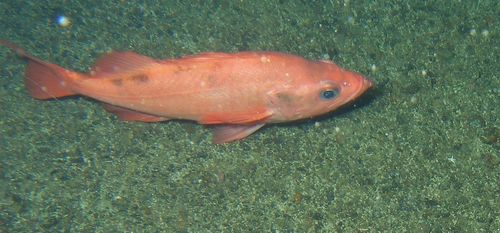
Pacific Ocean Perch
The Bluefin Tuna (Thunnus spp.) is a group of large, powerful, and highly migratory fish belonging to the Scombridae family. Renowned for their size, speed, and commercial value, they are apex predators in the marine ecosystem. Bluefin tuna play a critical role in the food web and are a prized catch in fisheries worldwide, especially for sushi and sashimi.
3 100 years
Lifespan
53 cm
Length
Endangered
Conservation Status
5 km/h
Swimming speed
Carnivorous
Diet
Local Migration
Migration
Appearance Overview
The Bluefin Tuna is renowned for its large, streamlined body, built for speed and endurance in the open ocean.
Coloration
Dark metallic blue above, shimmering silver below
Fins
Two dorsal fins, the second followed by small finlets
Body Shape
Torpedo-like, designed for efficient swimming
Length
Up to 10 feet (3 meters), commonly 6.5 feet (2 meters)
Weight
Up to 1,500 lbs (680 kg), commonly around 550 lbs (250 kg)
Diet
Carnivorous, feeding on a variety of fish, squid, crustaceans, and eels.
Feeding Behavior
Highly active predator, using speed and agility to hunt. They often hunt cooperatively, herding prey into tight groups.
Social Behavior
Forms large schools, especially during migration and spawning. Can be solitary or in smaller groups when feeding.
Commercial Relevance
Extremely high value, particularly in the sushi and sashimi markets. It is one of the most expensive fish species globally.
Conservation measures
Subject to international fishing quotas and regulations, marine protected areas, and efforts to improve fishing gear selectivity.
Status
Varies by species: Atlantic Bluefin (Endangered), Pacific Bluefin (Vulnerable), Southern Bluefin (Critically Endangered).
Threats
Overfishing is the primary threat. Other factors include bycatch, habitat degradation, and climate change affecting prey distribution.
Habitat Distribution
Depth Range
0-900 meters (0-2,953 feet), most commonly found in the upper few hundred meters.
Geographic Range
Atlantic Ocean, Pacific Ocean, Indian Ocean, and Mediterranean Sea.
Preferred Environment
Temperate and subtropical waters, open ocean (pelagic) environments.
Reproduction and Life Cycle
Breeding Habits
Spawns in specific areas, often in warm waters like the Gulf of Mexico and the Mediterranean Sea. Spawning is seasonal.
Development Stages
Eggs hatch into larvae, which develop rapidly in plankton-rich waters. Juveniles grow quickly, reaching considerable size within a few years.
Fecundity
Females can produce tens of millions of eggs per spawning season, depending on their size and condition.
Maturity Age
Varies by species, generally between 4-8 years for Atlantic Bluefin, and older for Southern Bluefin.
Faqs about Pacific Ocean Perch
Where are Bluefin tuna found?
Bluefin tuna are found in the Atlantic, Pacific, and Indian Oceans, as well as the Mediterranean Sea.
How long do Bluefin tuna live?
Bluefin tuna can live up to 40 years, though this varies by species.
Is it ethical to eat Bluefin tuna?
Yes, but it's crucial to choose sustainably sourced Bluefin due to overfishing concerns. Check for certifications like MSC.
How fast can Bluefin tuna swim?
They are among the fastest fish, capable of bursts of speed up to 43 mph (70 km/h).
What makes Bluefin tuna unique among fish?
Bluefin tuna are warm-blooded, which is rare among fish. This helps them maintain high activity levels in cold waters.
How far do Bluefin tuna migrate?
They migrate long distances across oceans for feeding and spawning, sometimes crossing entire ocean basins.
How many eggs can a Bluefin tuna lay?
A female can release millions of eggs in a single spawning season.
Copyright @ Nature Style Limited. All Rights Reserved.
 English
English